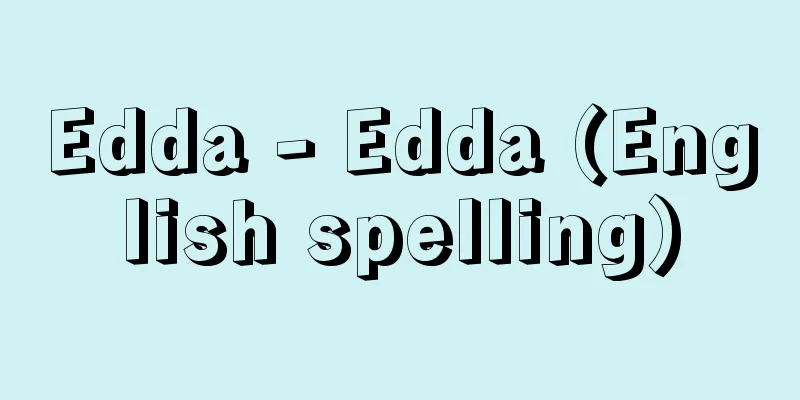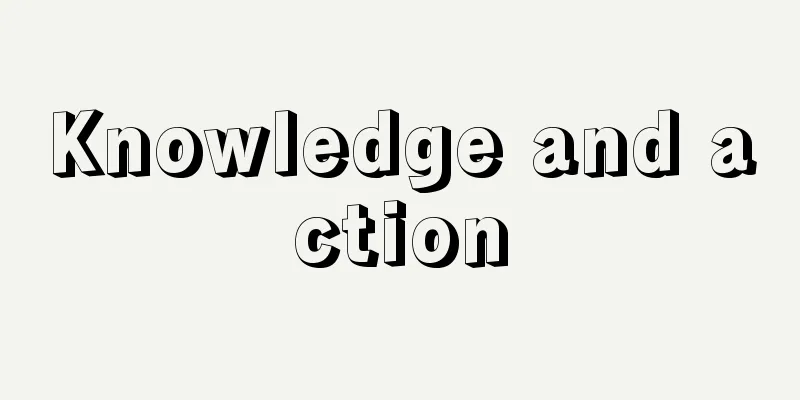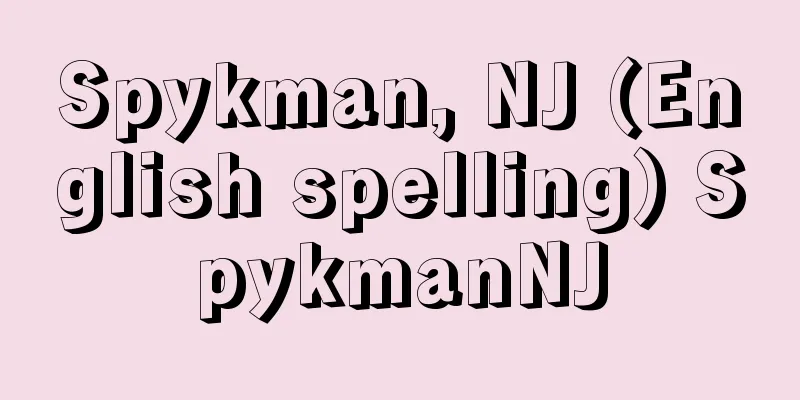Edda - Edda (English spelling)

|
A collection of songs from Norse mythology and heroic legends that was transmitted to Iceland. There are two works written in Old Norse called Edda, the older Edda is usually called the Poetic Edda, the Song Edda, or the Sämund Edda, and the other Edda, an introductory book on poetics written by the 13th century Icelandic scholar Snorri Sturluson, is distinguished as the Neo Edda or Prose Edda. The Poetic Edda is a collection of ancient songs from Norse mythology and heroic legends based on a manuscript discovered in Skálholt, Iceland in 1643, with the addition of several pieces from later manuscripts. It is written in three different rhythms, and is a powerful song with alliteration connecting words, a common feature of ancient Germanic poems such as Hildebrandslied, Beowulf, and Heliant. Although the author, time and place of each song are not known with certainty, they were probably written between the 9th and 13th centuries. The content consists of three parts: myths, heroic legends and proverbs. As the richest repository of Germanic mythology, mythological poetry provides the primary source of information for mythological and religious research. The Poetic Edda is the source of information about the creation of the world, the fierce battle between the gods and the giants, the destruction of the world, and the various forms of gods such as Odin, Thor and Loki. The heroic poems are divided into two groups: Helgi's Song and Nibrunngar's Song. Most of them deal with heroes from the history of the continent, giving a sense of the breadth of the legendary sphere. The Nibelungenlied works, which deal with the same material as the Nibelungenlied, are filled with the passionate heroic spirit of the Germanic people in simple and simple expressions, and provide excellent material for comparative studies of the two. Although most of the proverbs are based on mythology, they are also guidelines for life rooted in the real life of the Norse people. As can be seen from the "Proverbs of Odin" such as "Your fortune will perish, your loved ones will die, and you yourself will eventually die. But one thing that will never perish is your reputation," and "When a fool obtains wealth or the love of a woman, he becomes proud and arrogant, but he does not become sensible," the morals of the Norse are born from their calm and strict observation of humanity. The "Profound Edda" is composed of three parts. The first part, "Gylvi's Deception," takes the form of a frame story, and borrows the main plot from "The Prophecy of the Seeress" in the "Poetic Edda." It is an interesting overview of Norse mythology that artistically summarizes the deeds of the gods from the creation of the world to its destruction, weaving in vivid character descriptions and a variety of events. For example, the adventures of Thor in the land of the giants are not found in the Poetic Edda, and provide a valuable clue to understanding the Poetic Edda. Part 2, "The Words of the Poets," quotes the works of many poets of the same period to explain metonyms such as kennings (storm of weapons = battle) and introduce synonyms. It is valuable for its explanations of difficult poetic language and for including many works by poets that have been lost elsewhere. Part 3, "The Rhymes," is a collection of odes and comments that Snorri composed for King Haakon Haakonarsson and Duke Skuri, with whom he was friends. Snorri's Edda is the oldest Germanic introduction to poetics, and can also be said to be an introduction to Germanic mythology. [Yukio Taniguchi] "Edda - A Collection of Ancient Nordic Songs, translated by Yukio Taniguchi (1973, Shinchosha)" ▽ "Edda and Sagas, by Yukio Taniguchi (1976, Shinchosha)" Source: Shogakukan Encyclopedia Nipponica About Encyclopedia Nipponica Information | Legend |
|
アイスランドに伝えられた、北欧神話および英雄伝説の歌謡の集成。エッダという名でよばれる古ノルド語による作品は二つあり、普通、古いほうのエッダを『古エッダ』『歌謡エッダ』『セームンドのエッダ』とよび、もう一つの13世紀のアイスランドの学者スノッリ・スツルソンの書いた詩学入門書のほうを『新エッダ』『散文エッダ』などとして区別する。『古エッダ』は、1643年アイスランドのスカウルホルトで発見された写本をもとに、後世の写本から数編を加えた北欧神話、英雄伝説の古歌謡の集成である。3通りの韻律で書かれており、ゲルマンの古詩『ヒルデブラントの歌』『ベオウルフ』『ヘーリアント』などに共通の特徴といえる、頭韻で語句が結ばれた力強い歌謡である。個々の歌謡の作者や成立時代、場所については確実なことはわからないが、だいたい9世紀から13世紀にかけて成立したものらしい。内容は神話、英雄伝説、箴言(しんげん)の三つからなる。神話詩はゲルマン神話のもっとも豊かな宝庫として、神話や宗教研究の第一次資料を提供している。天地創造から、神々と巨人族の壮絶な戦い、世界の滅亡、またオーディン、トール、ロキなどの神々の多彩な形姿は、もっぱら『古エッダ』によって知ることができる。英雄詩は「ヘルギの歌」と「ニブルンガルの歌」の二つのグループに分けられる。大部分は大陸の歴史上の英雄を扱っていて、伝説圏の広がりを感じさせる。『ニーベルンゲンの歌』と同じ素材を扱った諸編は、簡潔素朴な表現のなかにゲルマン人の激情的な英雄精神をみなぎらせ、両者の比較研究に好個の材料を提供している。箴言は、多くは神話の枠に入っているが、北欧の民衆の現実生活に根ざした処世訓である。『オーディンの箴言』に記されている「財産は滅び、身内の者は死に絶え、自分もやがては死ぬ。だが、けっして滅びぬのが自らの得た名声だ」、「愚か者は財産か女の愛を手に入れると鼻高々となり増長するが、分別は増しはしない」などからもわかるように、北欧人の冷静で厳しい人間観察から生まれたモラルが示されている。『新エッダ』の内容は3部からなっている。第1部「ギュルビたぶらかし」は、枠物語の体裁をとり、『古エッダ』の「巫女(みこ)の予言」に大筋を借りて、世界の創造から破滅に至る神々の事績を、鮮やかな性格描写、多彩な事件を織り交ぜながら、芸術的にまとめた興味深い北欧神話概観である。たとえばトールの巨人の国での冒険などは『古エッダ』にない話で、『古エッダ』理解の有力な手掛りを与えてくれる。第2部「詩人のことば」は、ケニングという換喩(かんゆ)(武器の嵐(あらし)=戦い)の説明や同意語の紹介に、同時代の多くの詩人の作品を引用している。難解な詩語の説明と、ほかでは失われた詩人たちの作品が多数含まれている点が貴重である。第3部「韻律一覧」は、親交のあったノルウェーのハーコン・ハーコナルソン王とスクーリ侯のための、自作の頌歌(しょうか)とコメントである。このスノッリの『エッダ』は、ゲルマン最古の詩学入門書であると同時に、ゲルマン神話入門書ともいえる。 [谷口幸男] 『谷口幸男訳『エッダ――古代北欧歌謡集』(1973・新潮社)』▽『谷口幸男著『エッダとサガ』(1976・新潮社)』 出典 小学館 日本大百科全書(ニッポニカ)日本大百科全書(ニッポニカ)について 情報 | 凡例 |
<<: HST - High-Speed Stewardess
>>: Yue people - Etsuzoku (English spelling) Yuè zú
Recommend
Galilean relativity - Galilean relativity
…These inertial systems are all equivalent as far...
Yamatototohimomosohime no Mikoto
A daughter of Emperor Korei who appears in the Koj...
Haute Cour de Justice
The Supreme Court is made up of 12 members electe...
Arak
…In Japan, it was introduced from the Netherlands...
Woodworker - Kijiya
A shop run by a woodworker who makes turned woode...
Soil - Dojo (English spelling) soil
What is Soil? Soil is a product of the outermost ...
Bored - Aki
In psychology, this is called "mental satura...
Japanese-Portuguese Dictionary - Nipponjisho (English)Vocabulario da Lingoa de Iapam Portuguese
This dictionary was published by the Society of J...
《Caged Bird》 - Caged bird
…These films were not very different from the tra...
Clot retraction test
When normal blood leaves a blood vessel, it solidi...
furca
… Springtails have a unique, highly functional lo...
Brünn (English spelling)
...Population: 389,000 (1996). German: Brünn. Cat...
Forced ventilation - forced ventilation
...To prevent such unexpected flooding, preventiv...
Polymer gasoline
…When there is a high demand for gasoline, the re...
Greece (English spelling)
…In Latin, it is Graecia, and in modern European ...
![Legal Marxism (English spelling: legal'nyi marksizm [Russian])](/upload/images/67cb8c3b9fa96.webp)








